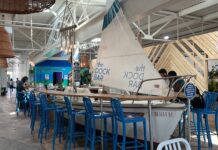When Tulsa-based interior designer Sallie Hughes, who with her sister, Beth Sachse, owns SR Hughes, went looking to relocate from her home in the country to a smaller city dwelling, she knew she wanted a place that still had a relationship to the outdoors. Light and a sense of space played a large part in her selection.
“To me the play of light, the courtyard and patio that bring the outdoors in – that appealed to me,” Hughes says of her Garden Park residence.
Both sides of her unit are covered in floor-to-ceiling expanses of glass that allow access from nearly every room to the courtyard and patio. High ceilings and ample storage add to the spacious feel that Hughes loves.
With more than 30 years of experience in design, it didn’t take her long to figure out where everything should go, especially when she used only items she already owned.
“It suites and delights me,” Hughes says of her collection of pieces, which include everything from a folding, English antique chaise and French daybed to modern Italian pieces from SR Hughes. “I’m a nester. When I walk in my home, well, there’s nowhere I feel more comfortable.”
Hughes’ signature design style is evident in the juxtaposition of traditional and modern elements throughout her home, like in her dining room where Cassina leather CAB armchairs share the stage with an antique English oak double gateleg drop-leaf table.
Another example is the living room. A rug by Odegard serves as the foundation. The space is complemented well by classic brown leather Le Corbusier chairs book-ending the sofa that is decorated with ethnic fabric pillows. Another juxtaposition that Hughes likes can be seen in the wingback chairs, inherited from her mother, and the bright orange Wassily leather sling chair by Knoll. The brightly colored painting that adds a punch of drama to the back wall of the room is a work by Hughes’ sister-in-law, Marsha Moore Hughes.
“If everything looks the same, then nothing stands out. To me an iconic piece of furniture or lighting gives an energy to the space,” Hughes shares.
The piece de resistance of the living room and of Hughes’ antique collection is the pine Chippendale-style secretary desk framed by two English leather chairs.
“It belonged to my mother and is my favorite antique,” she says with affection.
A common theme throughout the home is ethnic art and fabrics. Everything from Indian and African fabrics to Chinese primitive tables is featured.
“Something about ethnic influence speaks to my soul,” Hughes says.
Books are also something that speaks to this designer. An avid reader, Hughes was sure to create a bookshelf focal point in her master suite as well as golden-hued wingback chairs to enjoy.
Her study is another place where she enjoys her favorite hobby. A vintage green leather chair and a French daybed create a comfy feel where Hughes enjoys reading, and when she’s gone her two rescued dogs spend their time in the space.
Only a short time after finishing her own space, Hughes’ neighbor, Suzanne Brickner, asked for help with her condominium.
Brickner faced a dilemma most people do when downsizing. Her lovely Country French-inspired furniture was a little oversized for the layout of her new home. An avid cook and art collector, she wanted space and flow for both.
Working her magic, Hughes and Sachse showed Brickner how scale is the key to an engaging space. Using the traditional style of the home and high ceilings with wooden beams, Hughes paired a more modern touch that went along with Brickner’s taste.
Again, the foundation of the room is a striking Odegard rug from SR Hughes, which is anchored by the glass Cassina coffee table. The owner loves to collect glass birds, so Hughes created a natural space to show them. A pair of Kalos armchairs by Max Alto and a black leather Barcelona chair by Knoll add stylish comfort.
In the dining space, Hughes made two P. S. Gordon charcoal portraits, Brickner and her husband, the highlight and anchored them with an antique Chinese console from SR Hughes. The Ingo Maurer Birdie chandelier accented with feathers floats over a Cassina glass and wood La Rotunda table. Six burnt orange Cassina Hola chairs add just the right touch of color.
When it came to the outdoor space, Brickner achieved a Zen-like haven in which she can relax with creature comforts. In contrast, but still as relaxing, Hughes’ courtyard is deliciously overgrown with azaleas, boxwoods and other greenery.
“It’s full and wild and I love it,” Hughes says. It’s the perfect setting to enjoy the chiminea each night and a good book with her two canine companions.






















